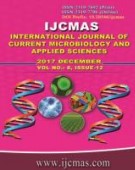


 National Academy of Agricultural Sciences (NAAS)
National Academy of Agricultural Sciences (NAAS)

|
PRINT ISSN : 2319-7692
Online ISSN : 2319-7706 Issues : 12 per year Publisher : Excellent Publishers Email : editorijcmas@gmail.com / submit@ijcmas.com Editor-in-chief: Dr.M.Prakash Index Copernicus ICV 2018: 95.39 NAAS RATING 2020: 5.38 |
Fly Ash, a waste material from thermal power station is now considered as a resource, based on its use in different sector. In agricultural sector it has been used to enhance soil fertility and improve crop productivity as a nutrient source and as soil ameliorant. With the view to use Fly Ash as an ameliorant for acid soil, the present investigation has been carried out during 2015 –2016 at Rice Research Station, Ambasamudram, where the soil was acidic (pH-4.75). This is a comparative study of fly ash application alone in different levels and in combination with different liming materials viz., Lime and Dolomite along with recommended dose of fertilizers on soil acid neutralizing capacity and nutrient availability of the soil. The treatments for the field experiment were laid out in RBD with 3 replications. The treatments include control, 100% RDF alone, Lime + RDF, Dolomite + RDF, FA @ 10,20,30 and 40 t ha-1 along with RDF, 50% Lime + 50% FA + RDF and 50% Dolomite + 50% FA + RDF. The pH of post-harvest soil ranged from 4.76 to 7.08. The highest value of 0.51% was observed for the addition of 50% dolomite + 50% FA + RDF which was 1.1 times increase over the control (0.24%). The bacterial (67 x 106 cfu gm-1 soil) and actinomycetes (59 x 103 cfu gm-1 soil) population of the post-harvest soil, recorded to be higher with the application of 50% Dolomite + 50% FA + RDF. The study on fungal population in post-harvest soil implied that, all the treatments imposed, recorded lower fungal count compared to that of the control (15 x 104 cfu gm-1 soil). The highest grain yield (5.93 t ha-1) and straw yield (6.32 t ha-1) were registered with 50% Dolomite + 50% FA + RDF.
 |
 |
 |
 |
 |